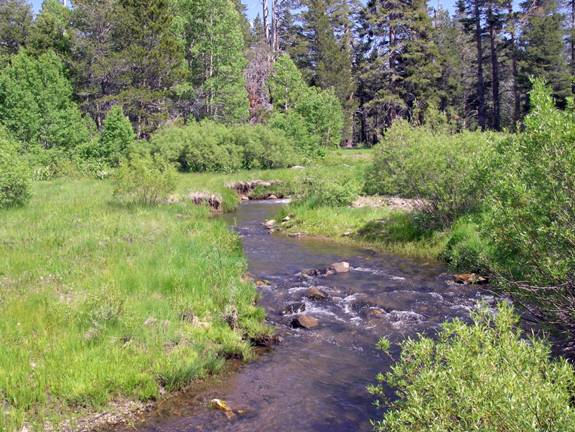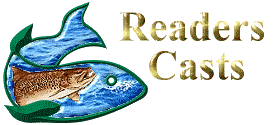TIPS FOR FISHING SMALL STREAMS

When given the choice between fishing a large river or a small stream I consistently choose the small stream. As I wrote in an article that was published recently in California Fly Fisher, "Small streams" — these words invoke fond memories dating back some 60 years. Growing up on the west slope of the Cascades in Oregon, my earliest fishing forays were along the streams of the Willamette River drainage. There, I developed an appreciation for the beauty and intimacy of small streams, qualities that larger waters can't match, and that is what motivates me to seek out small streams to fish."
In the high country of the Eastern Sierra Nevada where I fish, trout season is short and fish in the small streams that populate the region are aggressive and readily rise to a dry fly. Between run-off and early fall snow storms, the season may only be two to two and half months long. On most of those days you can find me fishing some small out of the way stream with an abundance of trout and no people.
What constitutes a small stream? While this is a question guaranteed to generate considerable disagreement among fly anglers, I define a small stream as a body of flowing water from a source that may itself be the origin of the stream, be formed by the juncture of two or more such streams, or be formed by the juncture of two or more of these combined streams. These are called first, second, and third order streams. First order streams are also called "headwaters", the place where the stream starts.
Small streams that aren't stocked are normally populated with small, wild trout but you can occasionally be surprised. Last summer I was fishing a stream that was so small you could stand with your feet on either side of it. I dropped a bushy dry fly into a little plunge pool about the size of a kitchen sink that produced a beautiful, thirteen inch Brook Trout.

There's another subject that will generate a lot of disagreement, and that's the question of what is the right rod to use on small streams. Some folks prefer a nine foot rod so they can "dap" the fly without having to approach the stream and scare the trout. Others like a shorter rod; I've seen five foot one and two weight rods described as "the ideal small stream rod". I think it's a personal choice and you should fish what you have and enjoy yourself. My own favorites are three bamboo rods I own, a seven foot Joe Arguello three weight, a seven foot Steve Kiley three/four weight, and a seven and a half foot Phillipson Peerless five weight.
My small stream lines are all Cortland Sylk double tapers with one tip section cut back into the front taper (not the belly) and rigged with a 7 ½ foot 4X leader that's been shortened to about six feet and twelve to eighteen inches of 4X tippet. Because most of my casts are going to be short I want the rod to load quickly and turn over the fly which this setup will accomplish. The heavier leader/ tippet allows me to rip my fly out of a bush or tree without disturbing the water, and fish on small streams are seldom leader shy unless they are in flat, still pools. When I need a longer tip section and front taper for larger waters I can always reverse the line on the reel.
Small stream trout are opportunistic feeders because most small streams don't support large hatches so forget about long, delicate leaders and small flies. These fish are looking for a big mouthful, and they feed on terrestrials more often than mayflies. A dry fly or terrestrial with wings you can easily see is usually the best choice.
My small stream fly box contains four basic dry fly patterns in sizes 12 to 18, Parachute Adams, light and dark Elk Hair Caddis, Royal Wulffs, and Ants. I also include some size 16 bead head Gold Ribbed Hares Ears and Pheasant Tail nymphs.
I leave my vest and net in the car. Instead I use a small backpack to hold some water, a couple of trail bars, and maybe a sandwich along with some bug repellent and sun screen. I use a lanyard with a pair of nippers, a hemostat, and some dry fly floatant, and tuck my fly box in one shirt pocket and a spool of tippet and an extra leader in the other.
I usually wet wade in small streams or wear hip boots or hippers. If I need more than that, then it's probably not a small stream.
To reduce the amount of time I spend in picking flies and small fish out of trees and bushes I normally use a short, sweep set rather than an up and back. Even if my fly winds up in a tree with a sweep set, chances are it will be at a height I can reach.
Tom Rosenbauer's excellent book titled "The ORVIS GUIDE to Small Stream Fly Fishing" and John Gierach's "Fly Fishing Small Streams" are two books every small stream angler should have in their libraries. They both contain a wealth of good information that can help you to develop into a better small stream fly fisher. Some of their suggestions include:
Ignore the junction of a small stream with the main river for a few hundred feet. Everybody fishes there.
Walk upstream from the main river until the casting begins to look difficult. Or if you are on a road well upstream from the main river, walk up or down until you get out of sight of any bridges
Don't walk the banks. Stay well away from the water—get to a point where you can't see the water—and then move upstream or down before fishing. Trout in small streams may not be the sharpest tools in the shed, but they are spooky!
Fishing upstream is almost always better, because you can approach the fish without spooking them. If you want to fish a stretch downstream of your position, walk downstream (stay away from the bank!) and then work up.
Be stealthy but move quickly. If a trout in a small stream doesn't take on the first or second cast, it is probably spooked and no amount of repeated fly casting will get it to rise.
Stay out of the water if at all possible because it's a great way to mess things up when you're trying to fish at short range.
Fishing a small trout stream properly is usually a matter of relaxing and slowing the pace.
Learn to make, short, accurate casts. If you can drop a fly into a hat at less than fifteen feet, you're well on your way to becoming a world class small stream fly fisher.
One more piece of advice – if you're not losing flies and getting tangled in the streamside vegetation, then you're missing some of the best fish in the stream. A lot of folks who fish small streams will pass up the difficult section that eats flies in favor of a more open spot that favors the fly fisherman and not the fish. There's nothing more exhilarating than getting a fly into a difficult spot and having a trout rise to it. It's why I fish small streams.
